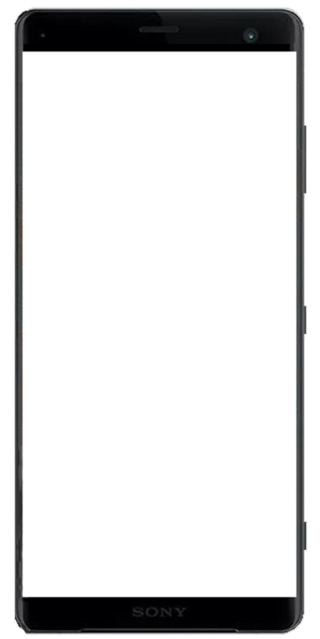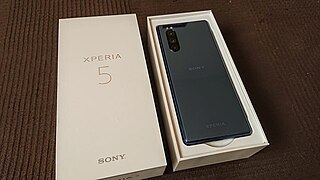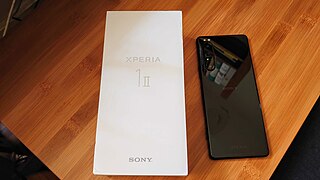
Sony Xperia T is an Android smartphone manufactured by Sony Mobile. Introduced on 29 August 2012, it is Sony Mobile's last device ever introduced to feature the Sony Ericsson liquid energy logo after Sony acquired Ericsson's stake in Sony Ericsson in January 2012. It was released in October 2012.

The Sony Xperia neo L is a mid-range Android smartphone designed, developed and manufactured by Sony Mobile Communications. The Xperia neo L as first announced in March 2012 and was released in June 2012. The Xperia neo L was first made available in China and was later on released globally.
The Sony Xperia XZ is an Android smartphone manufactured and marketed by Sony. Part of the Xperia X series, the device was announced to the public along with the Xperia X Compact at a press conference held at the annual IFA event on September 1, 2016. The Xperia XZ was first released in Taiwan on September 30, 2016, with worldwide sales starting with the United Arab Emirates on October 1 and the United States the following day; its home country Japan only started sales on November 2, 2016.

The Sony Xperia XZ Premium is an Android smartphone manufactured and marketed by Sony. As part of the Xperia X series, the device was announced to the public along with the Xperia XZs at the annual Mobile World Congress in February 2017. Pre-orders for the Xperia XZ Premium started in Europe on May 22, 2017. The device went on sale in the UK on June 2, 2017, and in the US on June 19, 2017.

The Sony Xperia XZs is an Android smartphone manufactured and marketed by Sony. Part of the Xperia X series, the device was announced to the public along with the Xperia XZ Premium at the annual Mobile World Congress last February 2017.

The Sony Xperia XZ1 Compact is a compact flagship Android smartphone manufactured and marketed by Sony. The phone was announced to the public along with the Sony Xperia XZ1 at a press conference which was held at IFA 2017 on August 31, 2017. It is the successor to the Sony Xperia X Compact and the first flagship-grade compact smartphone from Sony since the Sony Xperia Z5 Compact. It is known as the SO-02K in Japan, where it is exclusive to the NTT Docomo carrier.

The Sony Xperia XZ1 is an Android smartphone manufactured and marketed by Sony. Part of the Xperia X series, the device was announced to the public along with the Xperia XZ1 Compact at the annual IFA 2017 on August 31, 2017. It is the direct successor to the Sony Xperia XZ according to Sony, and is the latest flagship after the Xperia XZ Premium.
The Sony Xperia XZ2 is an Android-based smartphone unveiled, manufactured, released and marketed by Sony. Part of the Xperia X series, the device was announced to the public along with the Xperia XZ2 Compact at a press conference held at the annual 2018 Mobile World Congress event on February 26, 2018. It features Qi wireless charging, Dynamic Vibration System, 4K HDR video recording and has the standard 3.5 mm headphone jack removed.
The Sony Xperia XZ2 Premium is an Android smartphone manufactured and marketed by Sony. Part of the Xperia X series, the device was announced to the public on April 16, 2018, featuring a 4K HDR display and a MotionEye™ Dual Camera.

The Sony Xperia XZ3 is an Android smartphone manufactured and marketed by Sony. Part of the Xperia X series, the device was announced to the public at a press conference held at the annual 2018 IFA Berlin event on August 30, 2018. It is the first Xperia device with an OLED display and it features the same Dynamic Vibration System as seen on the Xperia XZ2. It was the last phone in the Xperia XZ series and the last phone in the Xperia X series overall before Sony moved into a new naming scheme for their Xperia lineup.

The Sony Xperia 1 is an Android smartphone made by Sony. Part of Sony's flagship Xperia series, the device was announced to the public at a press conference held at the annual 2019 Mobile World Congress event on February 25, 2019. It’s the world's first smartphone with an ultrawide 21:9 aspect ratio 4K HDR OLED display, dubbed Cinema Wide, and Sony's first triple-lens camera system featuring Eye AF eye-tracking technology seen in the company's Alpha line of professional-grade cameras. The Xperia 1 was later joined by a more compact device, the Xperia 5, which was revealed on 5 September 2019. Compared to the Xperia 1, the Xperia 5 has a smaller 1080p screen, a smaller battery, and a non-centrally aligned camera module.

The Sony Xperia 5 is an Android smartphone marketed and manufactured by Sony. Part of Sony's flagship Xperia series, it was unveiled at the annual IFA event on September 5, 2019. The device is a cheaper, more compact variant of the Xperia 1.

The Sony Xperia 1 II is an Android smartphone manufactured by Sony Mobile. Part of Sony's Xperia series, the phone was announced along with the mid-range Xperia 10 II on February 24, 2020. Key upgrades over its predecessor, the Xperia 1, include support for 5G connectivity and Qi wireless charging, and a triple-lens camera which incorporates ZEISS-branded lenses with T✻ (T-Star) anti-reflective coating as well as technology brought over from Sony's Alpha camera lineup.

The Sony Xperia 5 II is an Android smartphone marketed and manufactured by Sony Mobile. Part of Sony's flagship Xperia series, the phone was announced on September 17, 2020. A less expensive and more compact variant of the Xperia 1 II, the Xperia 5 II belongs to Sony's handset lineup of 2020, which includes the flagship Xperia 1 II and the entry-level Xperia 10 II. The phone was released worldwide in October 2020.
The Sony Xperia PRO is an Android smartphone manufactured by Sony Mobile. It is exclusive to the United States, Japan, and Europe, and is intended as a phone for video professionals, offering HDMI input and mmWave 5G connectivity.

The Sony Xperia 1 III is an Android smartphone manufactured by Sony. Designed to be the new flagship of Sony's Xperia series, the phone was announced along with the compact flagship Xperia 5 III and the mid-range Xperia 10 III on April 14, 2021.
The Sony Xperia 10 III is a mid-range Android smartphone manufactured by Sony Mobile. Part of Sony's Xperia series, it was unveiled alongside the Xperia 1 III & Xperia 5 III on April 14, 2021. It is the Sony's first Xperia mid-ranger to support 5G network.
The Sony Xperia PRO-I is an Android smartphone manufactured by Sony. Designed to be the new professional flagship of Sony's Xperia series, the phone was announced on October 26, 2021.

The Sony Xperia 1 IV is an Android smartphone manufactured by Sony. Launched on May 11, 2022, it succeeds the Xperia 1 III as the latest flagship of Sony's Xperia series. The device was announced along with the mid-range Xperia 10 IV, with expected release dates by June 2022 and as late as September 2022 for other markets including the US. US shipments were delayed and ultimately began in late October 2022.
The Sony Xperia 10 IV is a mid-range Android smartphone manufactured by Sony. Part of Sony's Xperia series, it was unveiled alongside the Xperia 1 IV on May 11, 2022.













